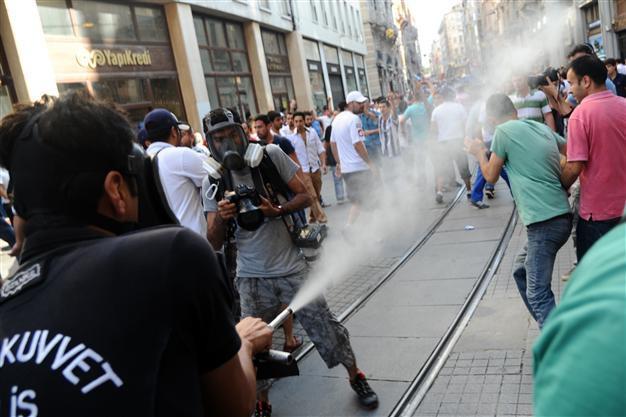Tear gas guidelines not the public’s business: Police
Nisan Su Aras ANKARA - Hürriyet Daily News

A Turkish anti-riot policeman uses tear gas to disperse protesters. aFP Photo
Guidelines regulating the use of tear gas in protest interventions, particularly the instructions received by police during the Gezi Park unrest, are not open to the public as the issue only concerns the police’s own staff, the Turkish police authorities have stated.A demand submitted by the Hürriyet Daily News on July 18 to access the “Gas Circular,” a critical guideline used by the police at the Gezi protests, which was also used as evidence in a European Court of Human Rights (ECtHR) decision, was rejected on Aug. 21. The rejection was based on the grounds that it is “beyond the scope of right to information.”
The “Gas Circular,” dated Feb. 15, 2008 (“EGM Genelge No: 19”), was sent to all security services by the Interior Ministry, whose circulars are usually open to public. It was also provided to the ECtHR to strengthen Turkey’s position in the “Yasa vs. Turkey” case referred to the court, in which Turkey was later found guilty. The guideline is known to have been valid during the peak of the Gezi protests, and the Interior Ministry published a renewed guideline on June 27.
“In line with Article 25 of the Law on Information stating that ‘Information and documents of institutions and organizations about regulations that do not concern the public opinion and are only about practices for its own staff and institution, is outside the scope of right to information. However, the institution in question reserves the right to inform its own staff who are affected by the regulation,’ your demand on the ‘Gas Circular’ dated Feb. 15, 2008 has not been met,” the police department’s answer to the HDN read.
Yusuf Alataş, a veteran lawyer who has represented clients at the ECtHR on many occasions, stated that keeping the guidelines from the public eye was not lawful.
“Normally, such circulars cannot be closed to public. This is not a state secret. The practices of the police, how the police are instructed, and how tear gas will be used, must be known, so that civil society organizations and the people are aware of the limits while exercising freedoms. It is a right to know after which point the actions of the police are against the law,” Alataş told the HDN on Aug. 22.
“These are orders about how the police will act when confronted by the people. In particular, it is everybody’s right to know how and under which circumstances they can use this substance, which is very harmful to human health. This is not ‘internal business,’” he added.
“These things are hidden from public opinion. If they weren’t, it would be easier for everybody to know under which circumstances the police can use gas, and to criticize the actions of the police. They [the police] do not want people to substantiate [their criticism] with official documents” Alataş said.
Despite the fact that such a circular served in Turkey’s advantage during the Yasa vs. Turkey case, and despite the fact it is not very different from the more recent circular that was widely reported by the media in light of sections published by the ECtHR, the police department chose not to disclose the document.
“We have a habit, which is to see oneself above the people and not to inform while governing. A reflex of rejection,” Alataş said.
According to the ECtHR case file, among other instructions, the latest police guideline states the following: “Before using tear gas, the crowd must be notified aloud that in the event of non-dispersion, tear gas will be resorted to. Tear gas cannot be fired targeting the human body. Tear gas, under no circumstances, can be used against those who prevented resistance or aggression. In addition, the escape routes of people affected by the gas should not be blocked. If escape routes are blocked, the crowd may become more aggressive.”
















